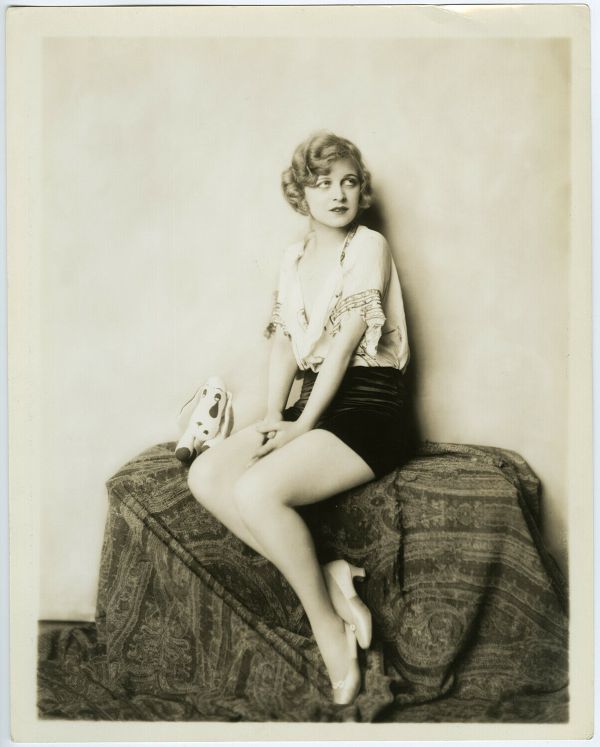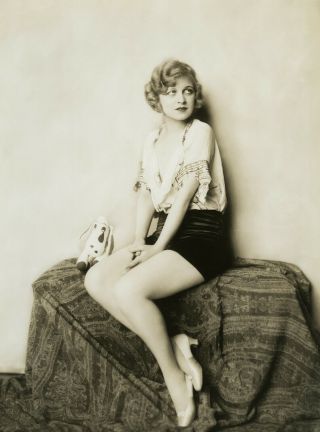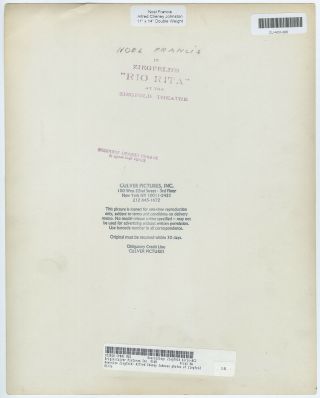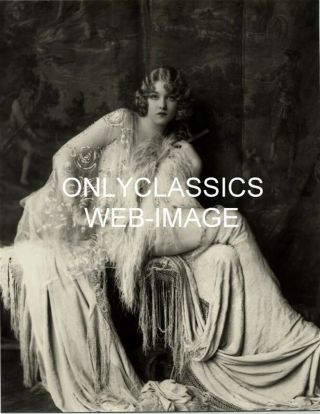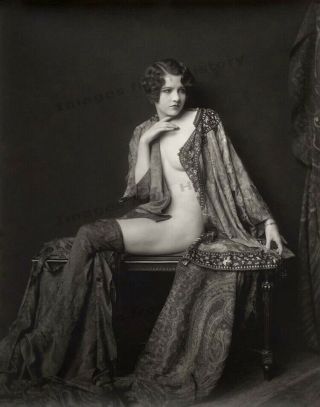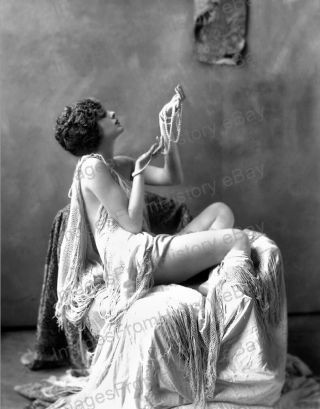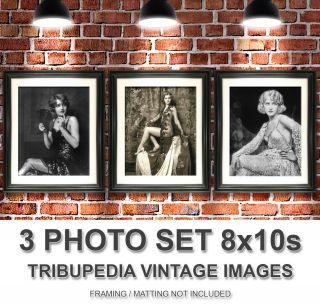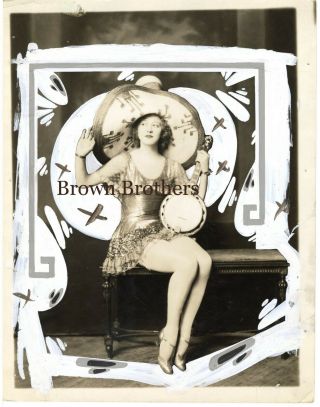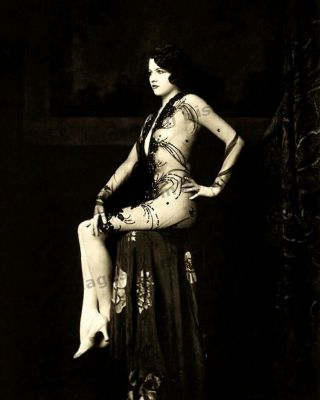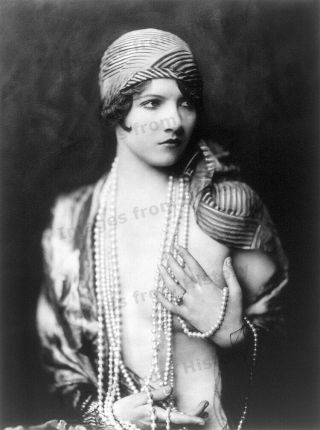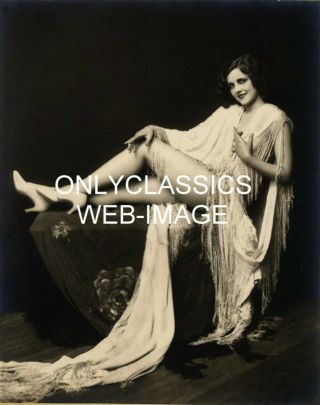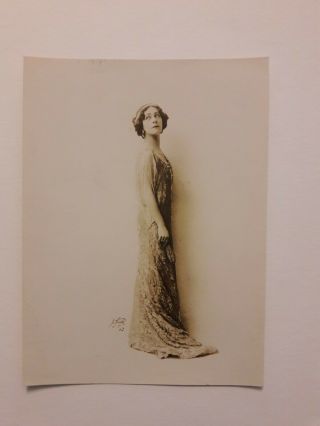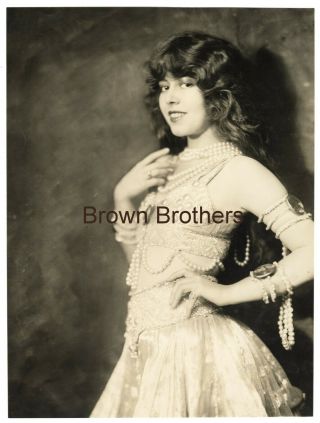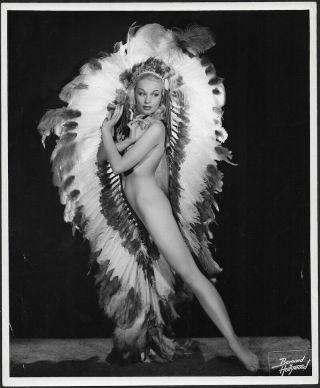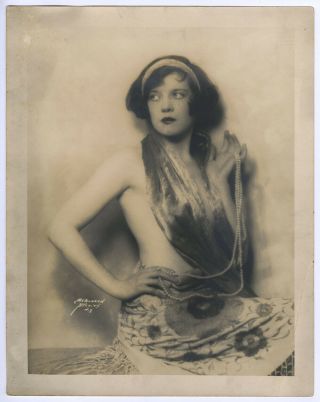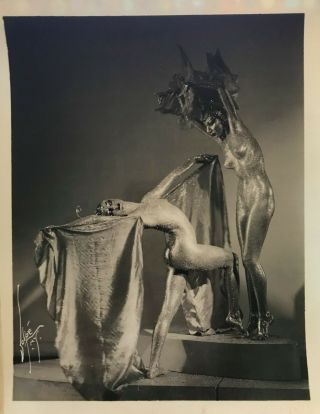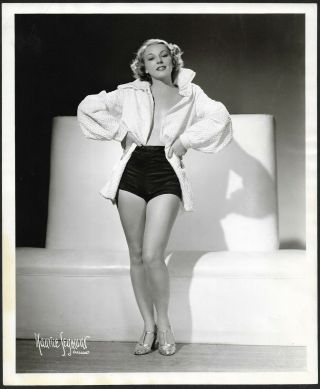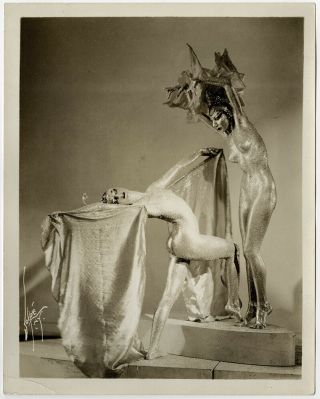Ziegfeld Follies Girl Noel Frances Large 1927 Alfred Cheney Johnston Photograph
Item History & Price
On offer here is a vintage hand printed portrait of stage and screen actress, and Ziegfeld girl Noel Francis. A quintessential John...ston portrait, Francis is beautiful in a pair of shorts and a blouse that is left unbuttoned tantalizingly low. She poses on a draped table top with a bleary-eyed stuffed dog. This portrait was used to promote Francis's appearance on stage at the Ziegfeld Theatre in the impresario's 1927 production of "Rio Rita."
Photograph measures 11" x 14" on a glossy double weight paper stock with the photographer's ink stamp, various other ink stamps, and notations on verso.
Guaranteed to be 100% vintage and original from Grapefruit Moon Gallery.
More about Noel Francis:
Noel Francis (born Noel Frances Sweeney, August 31, 1906 – October 30, 1959) was an American actress of the stage and screen during the 1920s and 1930s. Born in Texas, she began her acting career on the Broadway stage in the mid-1920s, before moving to Hollywood at the beginning of the sound film era. Originally cast in films for her song and dance abilities, when musicals began to fall out of favor, she became better known for her tough girl characters. However, by the mid-1930s, she was being typecast into smaller roles, and made an attempt at a comeback on Broadway. When that failed, she returned briefly to Hollywood to make several B films, before retiring in 1937.
Francis was born on August 31, 1906, in Temple, Texas, and grew up in Dallas. After high school, Francis attended Southern Methodist University and moved to New York City, where she attended Columbia University.
Her break came when she was 19 years old, when she was cast as a Ziegfeld girl in the Broadway production, Ziegfeld Follies of 1925. For the remainder of the decade she worked constantly for Florenz Ziegfeld, appearing in three more of his productions in featured roles, including a major role in the musical comedy, Rio Rita, which starred the comedy duo of Wheeler and Woolsey. Curiously, when Wheeler and Woolsey reprised their stage roles in a very successful 1929 film of the same name, Francis was not cast in the film, most likely because she was one of the stars in the Broadway production of Show Girl, which also starred Jimmy Durante, Eddie Foy, Jr., and Ruby Keeler.
While appearing in Show Girl, talent scouts from Fox Film saw her song and dance ability and signed her to a contract, intending for her to appear in musicals. Her debut film was in a featured role in the Fox's big budget musical of the year, New Movietone Follies of 1930. Her performance garnered good reviews by the New York Times, even though the film did not due well at the box office, due to flagging audience interest in these type of musical reviews. She had featured roles in two more films that year, including the John Ford comedy Up the River.
Due to the lack of success of Fox Movietone Follies of 1930, Fox dropped Francis' contract, but she quickly switched studios to Warner Bros., where she had her biggest film successes playing tough no-nonsense women. During this period in the early 1930s she had significant roles in several notable films. She had featured roles in two films with James Cagney in 1931, Smart Money and Blonde Crazy. In 1932, she had supporting and featured roles in numerous films, including what some said was her best role, as Linda in I Am a Fugitive from a Chain Gang, which starred Paul Muni. Both the film and Muni were nominated for an Academy Award.
However, after Fugitive, the roles offered to Francis began to be smaller, and in smaller films, although she continued to be quite active through the mid 1930s. In early 1935, she had one of her few starring roles, in Stone of Silver Creek, which also starred Buck Jones, with whom she developed a friendship. Not satisfied with the caliber of work she was getting, Francis attempted to resurrect her Broadway career, returning to New York, where she starred in Satellite, which lasted a single performance in November 1935. After her failure to re-launch her stage career, she returned to Hollywood, where she starred in two more westerns with Jones in 1937, before retiring.
Francis died in Los Angeles on October 30, 1959, at age 53.
Biography From: Wikipedia
More about Alfred Cheney Johnston:
Alfred Cheney Johnston was born into a New York banking family. Educated as a painter and illustrator at the National Academy of Design in New York City, he attracted the notice of Charles Dana Gibson. Shortly after graduating, he married in 1909 and for this reason did not serve in World War I. Johnston was cavalier about the information he dispensed about his beginnings. One myth, captured in a feature story about him in the Bridgeport Sunday Post of March 4, 1951, had him training at the Art Students League, photographing a student, and being hired by Ziegfeld when the sitter's family showed the image to the producer. According to legend, Ziegfeld invited him to the Midnight Frolic, looked over the portfolio, contracted with him and said, "Let's go back and meet the girls." In truth, shortly after his graduation from the Academy in 1908, Johnston attempted to become a portrait painter and failed. He took up the camera which he had used as an aid in his painting setups and made it the instrument of his art. He supported his wife by working as an uncredited retoucher and later camera artist for Sarony Studio.
By 1915 he had become one of the two chief photographers working for the most famous theatrical photography company in New York. Florenz Ziegfeld, taken with Johnston's portraits of showgirls in the 1915 and 1916 Follies and with two portrait sessions of Billie Burke, his wife, that were published in Vanity Fair, hired Johnston to photograph his theatrical enterprises. There was no long term contract--rather Johnston was paid by the job, a fact he revealed to newspaper columnist Charles B. Driscoll in 1938 when on the verge of retirement. Driscoll asked Johnston whether he ever had difficulty getting paid by Ziegfeld (an endemic problem for talent contracted for the Follies). "I know he often failed to pay bills, but in my case there was no difficulty. I was employed by the job. He would ask me to take on the work for a forthcoming production. We would agree on a price. So much work for so much money. He never quibbled over cost, and I was paid promptly."
Johnston's name appeared next to images for the first time in 1917. His portraits of showgirls in that year's edition of the "Follies" were featured conspicuously in the summer issues of Vanity Fair. They created a sensation. Thereafter, his images appeared in many of the important magazines: Photoplay, Motion Picture Classic, Shadowland, and The Theatre. Shooting primarily in his studio, Johnston became famous as the foremost chronicler of feminine beauty of the period. Movie stars, Broadway headliners, and society women come to be "glorified" by Johnston's camera. In 1918, Johnston developed a second career as an advertising photographer and became an important figure in the history of male fashion photography with his ad campaign for Dobbs Hats.
In 1920, shortly after James Abbe had contracted to work for Mack Sennett in Hollywood, Johnston allowed himself to be persuaded by director Allan Dwan to go West. Dwan, who was raiding the Follies for Jacqueline Logan, promised Johnston work as a still photographer, lighting designer, and wardrobe consultant. Johnston arrived in Los Angeles in November 1920, shot stills and publicity on "A Perfect Crime" and "The Forbidden Thing, " as well as numbers of portraits before the factory mentality of the studio drove him back East. Throughout the 1920s, he would be contracted for special production images for motion pictures, most frequently on movies designed by his friend and colleague at the Follies, Joseph Urban. With the exception of four images, these stills did not bear his name in print. At the same time, he privately experimented with color processes. His professional colleagues, out of respect for his artistry and technical prowess, made Johnston a trustee of the New York Camera Club in 1926.
When Ziegfeld died in 1932, Johnston's fame as a camera artist and commercial photographer was such that he weathered the Depression with little difficulty. In 1930, he became associated with Broadway producer-director, Alexander Leftwich, serving on his production team as art director for the musicals "Dollars Up" and "Daisies Won't Tell" which Johnston co-produced with Leftwich. Johnston incorporated himself on December 3, 1931, and began the direct sales of his nudes to the public, broadened his commercial work, and provided lighting design credited ["Sea Legs"] and uncredited for several Broadway productions.
In October of 1934 the Smithsonian Institution exhibited a selection of his portraits which garnered extravagant praise in the press. In 1937 Swan Publishing Co. of New York City issued a collection of Johnston nudes, Enchanting Beauty. It sold for 75 cents. Johnston retired in 1939 to Connecticut. In 1941 he revisited Hollywood, pondering the possibility of studio work. The studio system of publicity production still did not appeal to him, so he again returned East and "became an amateur." He died thirty-two years later in 1971. Shortly thereafter, in January of 1973, the Library of Congress mounted a memorial exhibition of his portraits. David S. Shields/ALS
Specialty: Johnston, while renowned for his glamour portraits of Ziegfeld girls and actresses, was a versatile artist adept at visualizing advertising imagery, urban landscapes, color still lifes, and production shots. Johnston was one of the creators of 20th-century glamour photography, giving his sitters erotic allure while vesting them with dignity and power. While his celebrity portraiture predominantly pictured women, his commercial imagery, particularly his famous campaign for Dobbs Hats projected masculine elegance. He was known in New York photographic circles for his color still lifes as well, though these never appeared in magazines.
His nude photography redefined the genre, creating a refined visual erotics differing from the vulgar French postcard and the misty nude dancers of pictorial photography. His late book, Enchanting Beauty, marked a departure from his early work, manifesting the surrealism and visual wit of Manasee studio in Vienna, and presenting visual homages to the nude styles of E.B. Hesser and Nickolas Muray. Johnston's approach to his photographic work was painterly. Indeed, in a significant number of his portrait and erotic images he painted backgrounds directly on the negative. What appears to be as painted backdrop or patterned wall is a semi-abstract impression hand rendered on the glass or film. (See the picture of Ada May Weeks.)
Johnston rarely discussed his photographic methods in print, and aside from professional talks on color processes, his public pronouncements about his photography tended to be recollections of shooting Ziegfeld showgirls and motion picture stars. Yet in one revealing interview with Violet Dare published in 1928, he spoke candidly about many of the dimensions of his art. "I just work in my own way . . . I don't imitate the methods of anyone else. And I break all the laws of photography whenever I see fit--not that I can see their value anyway! Why insist on having a shadow here and a high light there, simply because books have been written saying that you must? I suit everything to the personality of the person whose picture I'm making. Lights, background, composition-everything! I like to have a little talk with the person I'm going to photograph, before we get to work, two or three days before perhaps. We sit down here and talk things over, and I find out what kind of pictures are desired, and all that sort of thing. You see, a girl who wants to go into pictures or get on the stage, or who is already famous, perhaps, but needs new photographs, must have several kinds. She needs straight heads, full length pictures, some beautifully draped, some taken in decorative costumes. Her pictures must appeal to the editors of magazines and newspapers, as well as to theatrical producers. They are a large part of her stock in trade. I talk over her good points with her, suggest costumes, perhaps, though I always try to leave as much as possible to the girl herself. I don't believe a photographer should try to do the whole thing in his own way. If he does, he's going to get the same sort of pictures of everybody! Then, when I actually take the pictures, as I've said before, I suit everything to the sitter's personality. There's a great deal in having the right sort of lighting, of course. The background means a great deal. Take a picture of a draped figure, for instance. It may be rather coarse, unattractive, if it is done in the wrong way. But if the drapery is beautifully arranged, if the whole thing is made to look natural and simple, and the background which I paint into the negative harmonizes, the result is going to be beautiful. . . . I try to make not just a photograph of a girl's face and figure, but one of her personality as well, because when you look at a person your eye isn't photographic. You don't see just the features. In fact, you probably couldn't describe your best friend's face absolutely accurately, could you? You'd remember characteristics, interesting attributes, that would temper that memory. That's why photographs so often are disappointing--they show just what the eye sees. But take a photograph that has a definite atmosphere, that brings out a girl's elfin loveliness, her daintiness, her quiet, sweet charm, her spirit of gay camaraderie, and you've got a photograph that is going to mean something to her and her friends."
[Violet Dare comments on the beauty of the backgrounds and asks about them.] "I paint them in. . . . You see I studied art for ten years before I even thought of making photographs. I can't get away from it, of course. Now, the composition of a picture means a great deal. Take this, for instance ('this' being a picture of a pretty girl in a bit of black chiffon and lace, a charming piquant thing). Look at just the figure, without anything else; not so very nice, is it? But-with the drapery on the wall here, and this spray of leaves down the other side, the whole thing becomes more like a painting. . . . Take a woman in everyday life, a very beautifully gowned woman, say a dowager on her way to a wedding. Let her stand in the middle of a crowded elevator in a cheap department story. Instantly she is out of place, the effect of her manner, her gown, her breeding, is likely to be discounted, isn't it? She's in the wrong environment. Well, in my photographs I try to create the proper environment, just as we try to create it for ourselves in real life."
Violet Dare, "Is Your Beauty Invisible, " Wheeler Syndicate, 1928.
Biography By: Dr. David S. Shields, McClintock Professor, University of South Carolina, Photography & The American Stage | The Visual Culture Of American Theater 1865-1965



